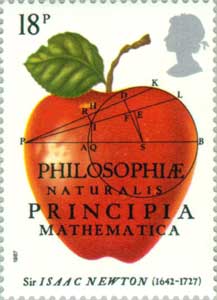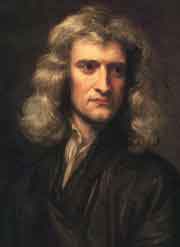
Sir Isaac Newton in Godfrey Kneller's 1689 portrait
Sir Isaac Newton (25 December 1642 20 March 1727 by the Julian calendar in use in England at the time; or 4 January 1643 31 March 1727 by the Gregorian calendar) was an English physicist, mathematician, astronomer, philosopher, and alchemist who wrote the Philosophiae Naturalis Principia Mathematica (published 5 July 1687), where he described universal gravitation and, via his laws of motion, laid the groundwork for classical mechanics. Newton also shares credit with Gottfried Wilhelm Leibniz for the development of differential calculus. While they both discovered calculus nearly contemporaneously, their work was not a collaboration.
Newton was the first to promulgate a set of natural laws that could govern both terrestrial motion and celestial motion. He is associated with the scientific revolution and the advancement of heliocentrism. Newton is also credited with providing mathematical substantiation for Kepler's laws of planetary motion. He would expand these laws by arguing that orbits (such as those of comets) were not only elliptic, but could also be hyperbolic and parabolic. He is also notable for his arguments that light was composed of particles (see wave-particle duality). He was the first to realise that the spectrum of colours observed when white light passed through a prism was inherent in the white light and not added by the prism as Roger Bacon had claimed in the 13th century.
Newton also developed a law of cooling, describing the rate of cooling of objects when exposed to air; the binomial theorem in its entirety; and the principles of conservation of momentum and angular momentum. Finally, he studied the speed of sound in air, and voiced a theory of the origin of stars.
Early life
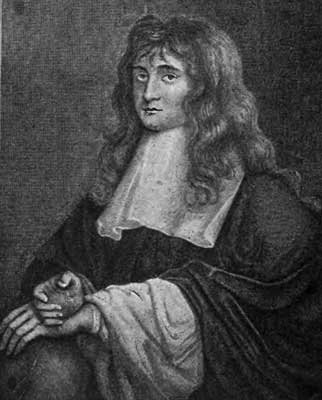
Young Newton , engraving by B. Reading after Sir Peter Lely.
The following is a brief biography of Newton's early life. For more in-depth information, see Isaac Newton's early life and achievements.
Newton was born in Woolsthorpe-by-Colsterworth, a hamlet in the county of Lincolnshire. Newton was premature and no one expected him to live; indeed, his mother is reported to have said that his body at that time could have fit inside a quart mug. His father had died three months before Newton's birth. When Newton was two years old, his mother went to live with her new husband, leaving her son in the care of his grandmother.
According to E.T. Bell (1937, Simon and Schuster) and H. Eves:
Newton began his schooling in the village schools and was later sent to Grantham Grammar School where he became the top boy in the school. At Grantham he lodged with the local apothecary, William Clarke and eventually became engaged to the apothecary's stepdaughter, Anne Storer, before he went off to Cambridge University at the age of 19. As Newton became engrossed in his studies, the romance cooled and Miss Storer married someone else. It is said he kept a warm memory of this love, but Newton had no other recorded 'sweethearts' and never married. [1]
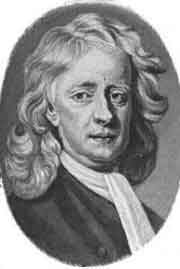
Engraving after Enoch Seeman's 1726 portrait of Newton
Newton was educated at Grantham Grammar School. In 1661 he joined Trinity College, Cambridge, where his uncle William Ayscough had studied. At that time the college's teachings were based on those of Aristotle, but Newton preferred to read the more advanced ideas of modern philosophers such as Descartes, Galileo, Copernicus and Kepler. In 1665 he discovered the binomial theorem and began to develop a mathematical theory that would later become calculus. Soon after Newton had obtained his degree in 1665, the University closed down as a precaution against the Great Plague. For the next two years Newton worked at home on calculus, optics and gravitation.
The popular tradition has it that Newton was sitting under an apple tree when an apple fell on his head, and that this made him understand that earthly and celestial gravitation are the same. A contemporary writer, William Stukeley, recorded in his Memoirs of Sir Isaac Newton's Life a conversation with Newton in Kensington on 15 April 1726, in which Newton recalled "when formerly, the notion of gravitation came into his mind. It was occasioned by the fall of an apple, as he sat in contemplative mood. Why should that apple always descend perpendicularly to the ground, thought he to himself. Why should it not go sideways or upwards, but constantly to the earth's centre." In similar terms, Voltaire wrote in his Essay on Epic Poetry (1727), "Sir Isaac Newton walking in his gardens, had the first thought of his system of gravitation, upon seeing an apple falling from a tree." These accounts are exaggerations of Newton's own tale about sitting by a window in his home (Woolsthorpe Manor) and watching an apple fall from a tree. It is now generally considered probable that even this story was invented by Newton in later life, to illustrate how he drew inspiration from everyday events.
Newton became a fellow of Trinity College in 1667. In the same year he circulated his findings in De Analysi per Aequationes Numeri Terminorum Infinitas (On Analysis by Infinite Series), and later in De methodis serierum et fluxionum (On the Methods of Series and Fluxions), whose title gave the name to his "method of fluxions".
Newton and Leibniz developed the theory of calculus independently, using different notations. Although Newton had worked out his own method before Leibniz, the latter's notation and "Differential Method" were superior, and were generally adopted throughout the English-speaking world. (Curiously, in Germany the Newtonian notation is more popular.) Though Newton belongs among the brightest scientists of his era, the last 25 years of his life were marred by a bitter dispute with Leibniz, whom he accused of plagiarism.
He was elected Lucasian professor of mathematics in 1669. Any fellow of Cambridge or Oxford had to be ordained at the time. However the terms of the Lucasian professorship required that the holder not be active in the church (presumably so as to have more time for science). Newton argued that this should exempt him from the normal ordination requirement, and Charles II, whose permission was needed, accepted this argument. This prevented the conflict that would have occurred between his nontrinitarian views and the orthodoxy of the church.
Scientific research
Optics
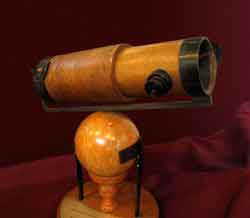
A replica of Newton's 6 inch reflecting telescope of 1672 for the Royal Society.
From 1670 to 1672 he lectured on optics. During this period he investigated the refraction of light, demonstrating that a prism could decompose white light into a spectrum of colours, and that a lens and a second prism could recompose the multicoloured spectrum into white light. From this work he concluded that any refracting telescope would suffer from the dispersion of light into colours, and invented a reflecting telescope (today, known as a Newtonian telescope) to bypass that problem. By grinding his own mirrors, using Newton's rings to judge the quality of the optics for his telescopes, he was able to produce a superior instrument to the refracting telescope, due primarily to the wider diameter of the mirror. (Only later, as glasses with a variety of refractive properties became available, did achromatic lenses for refractors become feasible.) In 1671 the Royal Society asked for a demonstration of his reflecting telescope. Their interest encouraged him to publish his notes On Colour, which he later expanded into his Opticks. When Robert Hooke criticised some of Newton's ideas, Newton was so offended that he withdrew from public debate. The two men remained enemies until Hooke's death.
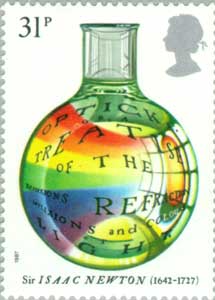
In one experiment, to prove that colour was caused by pressure on the eye, Newton slid a darning needle around the side of his eye until he could poke at its rear side, dispassionately noting "white, darke & coloured circles" so long as he kept stirring with "ye bodkin."
He once said, in a letter to Hooke dated 5 February 1676:
If I have seen a little further it is by standing on the shoulders of Giants.
In changing this quotation of Didacus Stella (Lucan (vol. II, 10)) from "Pigmies placed on the shoulders of giants see more than the giants themselves", Newton was perhaps making a more personal point than the mere expression of modesty — Hooke was a man of short stature.
Although is it widely known and accepted that there was considerable antagonism between Newton and Robert Hooke, Newton does make the occasional respectful reference to Hooke's work. For example in Opticks, Book I Part II, referring to the combining effect of colour filters, Newton refers to Hooke's experiments: " ... Mr Hooke tried casually with glass wedges filled with red and blue Liquors, and was surprised at the unexpected Event, the reason of it being then unknown; which makes me trust the more to his experiment, though I have not tried it myself." Thus Newton was not completely without respect for Hooke.
Newton argued that light is composed of particles; thus he could not explain the diffraction of light. Later physicists instead favoured a wave explanation of light to account for diffraction. Today's quantum mechanics recognises a "wave-particle duality"; however photons bear very little semblance to Newton's corpuscles (e.g., corpuscles refracted by accelerating toward the denser medium).
Newton is believed to have been the first to explain precisely, the formation of the rainbow from water droplets dispersed in the atmosphere in a rain shower. Figure 15 of Part II of Book one of Opticks shows a perfect illustration of how this occurs.
In his Hypothesis of Light of 1675, Newton posited the existence of the ether to transmit forces between particles. Newton was in contact with Henry More, the Cambridge Platonist who was born in Grantham, on alchemy, and now his interest in the subject revived. He replaced the ether with occult forces based on Hermetic ideas of attraction and repulsion between particles. John Maynard Keynes, who acquired many of Newton's writings on alchemy, stated that "Newton was not the first of the age of reason: he was the last of the magicians." Newton's interest in alchemy cannot be isolated from his contributions to science2. (This was at a time when there was no clear distinction between alchemy and science.) Had he not relied on the occult idea of action at a distance, across a vacuum, he might not have developed his theory of gravity. (See also Isaac Newton's occult studies.)
Gravity and motion
In 1679, Newton returned to his work on mechanics, i.e., gravitation and its effect on the orbits of planets, with reference to Kepler's laws of motion, and consulting with Hooke and Flamsteed on the subject. He published his results in De Motu Corporum (1684). This contained the beginnings of the laws of motion that would inform the Principia.
Philosophiae Naturalis Principia Mathematica (now known as the Principia) was published in 1687 with encouragement and financial help from Edmond Halley. In this work Newton stated the three universal laws of motion that were not to be improved upon for more than two hundred years. He used the Latin word gravitas (weight) for the force that would become known as gravity, and defined the law of universal gravitation. In the same work he presented the first analytical determination, based on Boyle's Law, of the speed of sound in air.
With the Principia, Newton became internationally recognised. He acquired a circle of admirers, including the Swiss-born mathematician Nicolas Fatio de Duillier, with whom he formed an intense relationship that lasted until 1693. The end of this friendship led Newton to a nervous breakdown.
For a detailed discussion on the writing of Principia, see the writing of Principia Mathematica.
Later life
The following is a brief biography of Newton's later life. For more in-depth information, see Isaac Newton's later life.
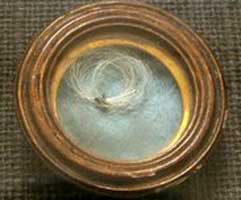
A lock of Newton's hair in Trinity College, Cambridge.
In the 1690s Newton wrote a number of religious tracts dealing with the literal interpretation of the Bible. Henry More's belief in the infinity of the universe and rejection of Cartesian dualism may have influenced Newton's religious ideas. A manuscript he sent to John Locke in which he disputed the existence of the Trinity was never published. Later works — The Chronology of Ancient Kingdoms Amended (1728) and Observations Upon the Prophecies of Daniel and the Apocalypse of St. John (1733) — were published after his death. He also devoted a great deal of time to alchemy (see above)2.
Newton was also a member of Parliament from 1689 to 1690 and in 1701, but his only recorded comments were to complain about a cold draft in the chamber and request that the window be closed.
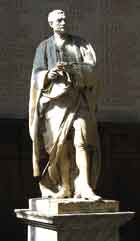
Statue of Newton in the antechapel of Trinity College, Cambridge
Newton moved to London to take up the post of warden of the Royal Mint in 1696, a position that he had obtained through the patronage of Charles Montagu, 1st Earl of Halifax, then Chancellor of the Exchequer. He took charge of England's great recoining, somewhat treading on the toes of Master Lucas (and finagling Edmond Halley into deputy comptroller of the temporary Chester branch). Newton became master of the Mint upon Lucas' death in 1699. These appointments were intended as sinecures, but Newton took them seriously, exercising his power to reform the currency and punish clippers and counterfeiters. He retired from his Cambridge duties in 1701. Ironically, it was his work at the Mint, rather than his contributions to science, which earned him a knighthood.
In 1701 Newton anonymously published a law of thermodynamics now known as "Newton's law of cooling" in the Philosophical Transactions of the Royal Society.
In 1703 Newton became President of the Royal Society and an associate of the French Académie des Sciences. In his position at the Royal Society, Newton made an enemy of John Flamsteed, the Astronomer Royal, by attempting to steal his catalogue of observations.
In 1704 Newton wrote Opticks, in which he expounded his corpuscular theory of light. The book is also known for the first exposure of the idea of the interchangeability of mass and energy: "Gross bodies and light are convertible into one another...".
Newton was knighted by Queen Anne in 1705, not for his scientific achievements but for his political presence.
Newton never married, nor had any recorded children. He died in London and was buried in Westminster Abbey. It is believed Newton never had a romantic relationship, and he is said to have died a virgin. His niece, Catherine Barton Conduitt3, served as his hostess in social affairs at his house on Jermyn Street in London; he was her "very loving Uncle"4, according to his letter to her when she was recovering from smallpox.
Religious views
The law of gravity became Sir Isaac Newton's best-known discovery. Newton warned against using it to view the universe as a mere machine, like a great clock. He said, "Gravity explains the motions of the planets, but it cannot explain who set the planets in motion. God governs all things and knows all that is or can be done."
Though he is better known for his scientific achievements, the Bible was Sir Isaac Newton's greatest passion. He devoted more time to the study of Scripture than to science, and said, "I have a fundamental belief in the Bible as the Word of God, written by those who were inspired. I study the Bible daily."
Newton was secretly a unitarian and arian; he did not believe in the church's doctrine of divine trinity. Had this become known while he lived, the law would have required his removal from his position as a professor in Cambridge University. His writings on this topic were published only posthumously.
He unsuccessfully attempted to find hidden messages within the Bible
Newton's legacy
Newton's laws of motion and gravity provided a basis for predicting a wide variety of different scientific or engineering situations, especially the motion of celestial bodies. His calculus proved vitally important to the development of further scientific theories. Finally, he unified many of the isolated physics facts that had been discovered earlier into a satisfying system of laws. For this reason, he is generally considered one of history's greatest scientists, ranking alongside such figures as Einstein and Gauss.
Also on a more practical level, to a large portion of households, Newton invented the cat flap. This was said to be done so that he wouldn't have to disrupt his optical experiments, conducted in a darkened room, to let his cat in or out.
Fictional appearances
Isaac Newton is the hero of Rubrique-à-brac, a French comic strip by Marcel Gotlieb. An ongoing gag involves various depictions of the legend that he discovered the law of gravity due to an apple falling on his head.
Newton also figures as a major character in Neal Stephenson's Baroque Cycle.
Newton appeared, along with Stephen Hawking and Albert Einstein in a poker game in an episode of Star Trek: The Next Generation. Newton was notable in that scene for being the only scientist without a sense of humour. He also took offence at the notion that the story of the apple was fictitious.
It is hinted that Isaac Newton is the true identity of Emperor Dornkirk in Vision of Escaflowne, although there are only hints and no actual confirmation.
Newton often appears in the animated series "The Simpsons". One of the more memorable scenes that he appears in is when he is playing chess against Jimi Hendrix in heaven and Newton says:"That's game, Hendrix!"
Quotations about Newton
"The Principia is pre-eminent above any other production of human genius." —Pierre-Simon Laplace
"Taking mathematics from the beginning of the world to the time when Newton lived, what he has done is much the better part." —Gottfried Leibniz
"All that has been accomplished in mathematics since his day has been a deductive, formal, and mathematical development of mechanics on the basis of Newton's laws." —Ernst Mach
"Nature and Nature's laws lay hid in night: God said, Let Newton be! and all was light." —poem, Alexander Pope
Writings by Newton
- Method of Fluxions (1671)
- De Motu Corporum (1684)
- Philosophiae Naturalis Principia Mathematica (1687)
- Opticks (1704)
- Reports as Master of the Mint (1701-1725)
- Arithmetica Universalis (1707)
- An Historical Account of Two Notable Corruptions of Scripture(1754)
- Short Chronicle, The System of the World, Optical Lectures, Universal Arithmetic, The Chronology of Ancient Kingdoms, Amended and De mundi systemate were published posthumously in 1728 , See the part: A short chronicle: From the First Memory of things in Europe to the Conquest of Persia by Alexander the Great
Notes
Note 1: The remainder of the dates in this article follow the Gregorian calendar.
Note 2: Westfall (pp. 530–531) notes that Newton apparently abandoned his alchemical researches.
Note 3: Westfall, p. 44.
Note 4: Westfall, p. 595.
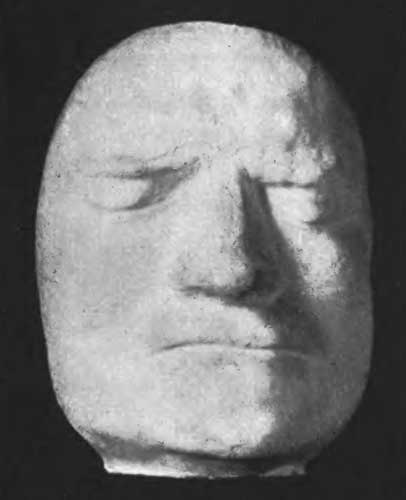
Isaac Newton Death Mask
Resources
References
- Bell, E.T. (1937). Men of Mathematics. New York: Simon and Schuster. ISBN 0671464000.
- Christianson, Gale (1984). In the Presence of the Creator: Isaac Newton & his times. New York: Free Press. ISBN 0029051908.
- "interview with James Gleick: "Isaac Newton" (Pantheon)". WAMU's The Diane Rehm Show Friday, June 13, 2003 (RealAudio stream). URL accessed on March 8, 2005.
- "Sir Isaac Newton". School of Mathematics and Statistics, University of St. Andrews, Scotland. URL accessed on March 8, 2005.
- "The Newton Project". Imperial College London. URL accessed on March 8, 2005.
- Westfall, Richard S. (1980, 1998). Never at Rest. Cambridge University Press. ISBN 0521274354.
Further reading
- John Maynard Keynes, Essays in Biography, W W Norton & Co, 1963, paperback, ISBN 039300189X. Keynes had taken a close interest in Newton and owned many of Newton's private papers.
- Isaac Newton, Papers and Letters in Natural Philosophy, edited by I. Bernard Cohen ISBN 0-674-46853-8 Harvard 1958,1978
- Michael H. Hart, The 100, Carol Publishing Group, July 1992, paperback, 576 pages, ISBN 0806513500
- Simmons, J, The giant book of scientists -- The 100 greatest minds of all time, Sydney: The Book Company, (1996)
- Isaac Newton (1642-1727), The Principia: a new Translation, Guide by I. Bernard Cohen ISBN 0-520-08817-4 University of California 1999 Warning: common mistranslations exposed!
- Berlinski, David, Newton's Gift:How Sir Isaac Newton Unlocked the System of our World, ISBN 0684843927 (hardback), also in paperback, Simon & Schuster, 2000
- Stephen Hawking, ed. On the Shoulders of Giants, ISBN 0-7624-1348-5 Places selections from Newton's Principia in the context of selected writings by Copernicus, Kepler, Galileo and Einstein.
- James Gleick, Isaac Newton, Knopf, 2003, hardcover, 288 pages, ISBN 0375422331
Retrieved from "http://en.wikipedia.org/"
All text is available under the terms of the GNU Free Documentation License
